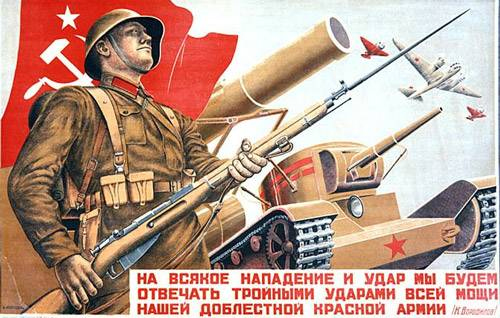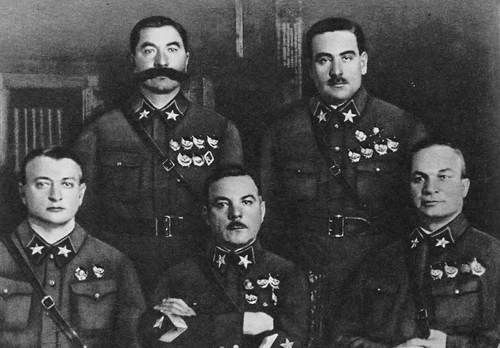● ● ●
In World
War II, some 25 million Soviet citizens served in the armed
forces of the USSR, mostly in the Red Army. Well over eight
million were killed in action, or died of wounds, or died as
prisoners of war in the hands of the Germans. Many—nothing
like exact numbers can be cited—were killed by their own
side. The “supreme measure”—summary execution—was a standard
disciplinary measure, liberally applied for such crimes as cowardly
behavior, desertion or incompetence.
Yet
despite those astronomical casualties, the Red Army emerged
victorious from the twentieth century’s most barbaric and
vicious war. At enormous cost—and with considerable outside
aid—the USSR destroyed National Socialist Germany, ending
the war with its troops in occupation of Berlin. How this
happened, how the Red Army met catastrophe at the beginning
of the Nazi-Soviet War, survived and refashioned itself, and
finally defeated a formidable enemy, is a story of absorbing
interest.
When World War II began the Red
Army was superficially quite similar to the armies of other
major powers. Like them it had its field armies, corps,
divisions, brigades and regiments, its officer corps, its
general staff. But appearances were deceptive for in reality the Red Army
suffered from deficiencies that very nearly brought down the
Soviet state. These deficiencies can be summarized under two
headings: structural and political.
In the
1930s the Red Army acquired a reputation as one of the most
forward-thinking, militarily progressive armies in the
world. Its mechanized forces—tanks and motorized
infantry—made a striking impression on foreign observers. It
was a pioneer in the development of parachute troops. In the
Russian military tradition, its artillery seemed
incomparably powerful. And of course it was very large,
there being a pool of more than 30 million men of military
age to draw upon. But paradoxically, that very size was a
source of weakness.

The invincible Red Army as depicted in
Soviet propaganda. The reality was somewhat different.
By the
mid-twentieth century the art of war had developed so far as
to require a great deal of technical expertise. Mechanized
and airborne forces, artillery, communications,
military mobilization—all depended for their effectiveness on large
amounts of up-to-date equipment and strong cadres of
technical specialists. Soviet propaganda made much of the
regime’s success in industrializing the country and
providing the required specialists through an improved
educational system. But the truth was that the results
achieved were inadequate relative to the great size of the
Red Army. All too often, the tables of organization of its
units were aspirational rather than actual. Many of the
divisions titled mechanized and motorized in
1939-41 were no such thing, since the requisite equipment
was lacking. And even when it was, the insufficiency of
technically qualified men was a handicap. The artillery
regiment of an infantry division might have its authorized
82 guns and howitzers—but not the full complement of trained artillerymen
necessary to make the most efficient use of them.
These
structural deficiencies were exacerbated by political
factors peculiar to the Soviet regime. Stalin’s desire to
turn the USSR into a major military power was accompanied by fear and distrust of the Red Army, which was
one of two Soviet institutions with the power to depose him.
(The other was the NKVD.) This obsession with political
reliability led him to apply the method of the purge to the
Army in 1937-38. Virtually the whole military high command
was wiped out, along with a significant percentage of the
officer corps as a whole. They were replaced by new men who,
with the fate of their predecessors before their eyes, could
be expected to remain loyal—the more so as they were closely
supervised by a corps of “political officers,” parallel to
the military chain of command, answerable to the Party, i.e.
to Stalin.

Marshals of the Soviet
Union, 1936. A year later three of these men were arrested,
tried for treason and shot. (Red Army)
But the
demanded loyalty was procured at the cost of military
competence. Company commanders found themselves abruptly
promoted to the command of regiments, battalion commanders
to the command of divisions, brigade commanders to the
command of corps. And for the most part these new men were
not prepared for their new responsibilities, either by
training or temperament. The example of the purge had driven
out of them all initiative and independence of thought.
Thus
when war came to the USSR in the summer of 1941 the Red Army
suffered defeat after costly, calamitous defeat.
It remains
a matter of dispute whether Germany could have defeated the
USSR but by all appearances it came close to doing so in
1941. In this series, a companion piece to my series on the
German Army in World War II will be examined the process by
which the Red Army restructured itself in the course of the
war to align its structure with its capabilities.
● ● ●